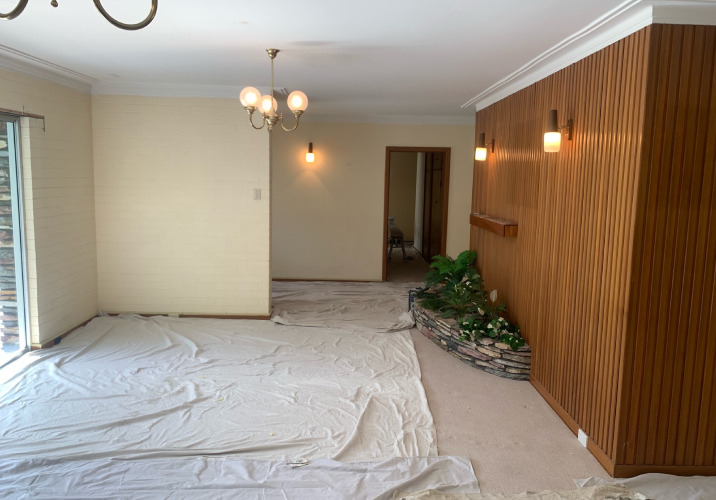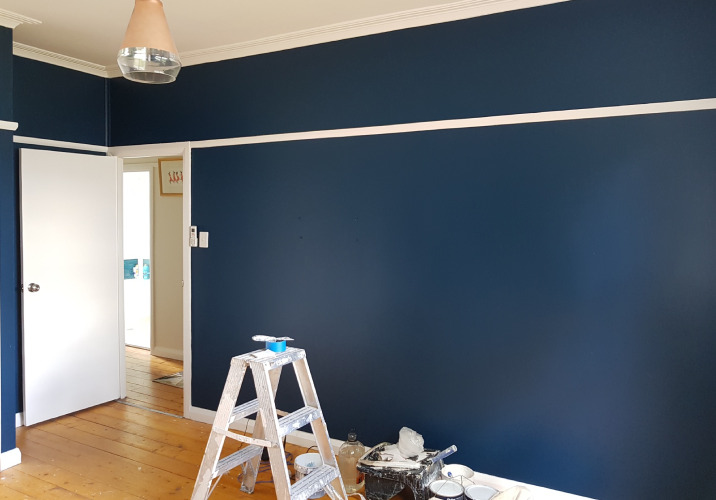
Find a local painter
- Inspiration /
- Indoor projects /
- Walls & flooring /
- How to paint a wall
How to paint a wall
Learn to paint like a professional
How to prep walls for painting
Fill in surface cracks
Before you look for easy painting ideas, make sure that you know how to prep the walls. You should start with a quick inspection for cracks in the wall. Filling in those cracks with putty and letting it dry overnight ensures that your paint goes on smoothly and that you don’t need multiple coats.
Sand down
If you filled in surface cracks, you need to sand down those cracks before painting. Fine grit sandpaper removes any excess putty and won’t leave behind scratches and gouge marks. You generally want to let the putty dry overnight before sanding it.
Clean walls
As you look for painting tips, you will find that many people recommend cleaning your walls before painting those surfaces. All you need is a little dish soap that you mix with water and apply it to the walls. Cleaning the wall removes any substances that can keep the paint from sticking.
Apply tape a lay a drop sheet
When preparing walls for painting, both painter’s tape and masking tape works well. It goes on smoothly and comes off cleanly without leaving residue behind. Use the tape to block off your outlet and baseboards as well as any other surfaces that you do not want to paint. It’s also a good idea to lay a drop cloth will protect the floors from the paint.

Purchase enough paint
Always determine how much paint you need before starting the job, especially if you choose a custom blend. Though home improvement stores follow paint mixture recipes, they cannot guarantee that a new batch will perfectly match your old batch of paint. One litre of paint will cover up to 6.5 square metres. Measure the size of the room and divide it by 6.5 to roughly see how many litres of paint you need.
Required tools
- Paint/masking tape
- Drop cloths
- Primer: Tinted primers match the colour of the paint that you choose and reduce the amount of paint needed. When painting interior walls, you should always use at least one coat of primer first.
- Brushes: Brushes are helpful for painting areas that you cannot reach with a roller and blending the borders and corners of a room with the rest of the wall.
- Rollers: To paint a large room in less time, invest in one or more rollers. Rollers are also reusable. Once you finish painting, rinse off the rollers with some clean water and let them sit outside for a few hours to dry. You can use them when you need to repaint or touch up a room later.
- Tray
- Ladder: A ladder helps you reach the top of the room and apply both the paint and primer. It also helps you stay safe until the job is done.
- Clean cloth: Having a few clean and dry cloths nearby can help you take care of accidents as they happen. If you knock over a can of interior wall paint, you can quickly mop it up before it creates a permanent stain. A dry cloth will also help you remove paint that drips onto other surfaces.
Tips for painting a wall
How to cut in painting
Cutting in painting is a technique that helps the areas around the corners and baseboards blend with the rest of the wall. Whether you use a brush or roller, go over those surfaces with a brush. Use the brush to apply smooth, streaks of paint around the border or corner and pull the brush towards the centre of the room. You can then go over those areas with a roller to smooth out any rough spots.
Contact local painters
How to paint a wall with a roller
Learning how to paint with a roller can save you some time because the roller covers a larger area with paint in less time than it would take with a brush. Pour enough paint in your trap to completely coat the bottom and fill it halfway up the sides. Run the roller through the paint and along the base of the tray. When you pull it towards you, the tray removes any excess paint from the roller. You should then paint a large uppercase “W” in the centre of the wall. As you use more paint, expand the size of the W and move the roller in different directions. This helps you fill in gaps and provides a smooth coat of paint.
How long does it take paint to dry?
The amount of time it takes for the paint to dry depends on the type of paint that you used. It typically takes six to eight hours for most interior house paints to dry. If you use a primer, you need to wait at least an hour for it to dry before applying the paint. You should not remove the tape or move back into the room until you give the paint a full 24 hours to dry. High humidity levels and cold temperatures are two factors that can increase the drying time.
How many coats of paint do you need for a wall?
Most walls need a minimum of two coats. Even if you use a primer, you need two coats of paint. Apply the first and let it dry completely before applying the next coat. If you find that traces of the old paint are still showing, you’ll need to apply a third coat. You may need multiple coats to hide brush marks and other mistakes, too.

How long does it take to paint a room?
It’s difficult to say how long it takes to paint a room because it depends on the size of the space and how quickly you work. Plan on spending at least four hours to paint a smaller room and up to six hours to paint a larger room. If you use any unique or custom painting techniques, the process will take even longer.
Tips for painting a feature wall
A feature wall is usually a different colour to the other walls and serves as a focal point in a home. When painting a feature wall, choose colours that work together and use a roller to provide an even coat of paint. You may want to use stencils to add a unique design to the wall, too.
How to hire a painter
Licensing and qualifications
Whether you want to know how to repaint a wall or where to start on your project, consider hiring a pro. Painters in Australia need a Certificate III in Painting and Decorating. They can get this through a registered organisation or a specialty institution. Some also receive their training through an apprenticeship program.
How much will your job cost?
The Oneflare Cost Guide Centre is your one-stop shop to help you set your budget; from smaller tasks to larger projects.



